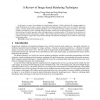CG
1999
Springer
14 years 5 months ago
1999
Springer
Projective texture-mapping is a powerful tool for image-based rendering. However, visibility information must be obtained in order to project correct textures onto the geometric s...
IJCV
2007
14 years 5 months ago
2007
In this paper, we propose a stereo method specifically designed for image-based rendering. For effective image-based rendering, the interpolated views need only be visually plaus...
VMV
2007
14 years 6 months ago
2007
Whenever approximate 3D geometry is projectively texture-mapped from different directions simultaneously, annoyingly visible aliasing artifacts are the result. To prevent such gho...
VCIP
2000
14 years 6 months ago
2000
In this paper, we survey the techniques for image-based rendering. Unlike traditional 3D computer graphics in which 3D geometry of the scene is known, image-based rendering techni...
SIGGRAPH
1995
ACM
14 years 9 months ago
1995
ACM
Image-based rendering is a powerful new approach for generating real-time photorealistic computer graphics. It can provide convincing animations without an explicit geometric repr...
PG
1997
IEEE
14 years 9 months ago
1997
IEEE
A plenoptic function is a parameterized function describing the flow of light in space, and has served as a key idea in building some of the recent image-based rendering systems....
RT
1998
Springer
14 years 9 months ago
1998
Springer
Image warping is desirable in the context of image-based rendering because it increases the set of viewpoints for which a single image can be used. This paper proposes a method for...
RT
1998
Springer
14 years 9 months ago
1998
Springer
Most current image-based rendering methods operate under the assumption that all of the visible surfaces in the scene are opaque ideal diffuse (Lambertian) reflectors. This paper i...
SIGGRAPH
1998
ACM
14 years 9 months ago
1998
ACM
In image-based rendering, images acquired from a scene are used to represent the scene itself. A number of reference images are required to fully represent even the simplest scene...
VISUALIZATION
2000
IEEE
14 years 9 months ago
2000
IEEE
This paper presents an efficient keyframeless image-based rendering technique. An intermediate image is used to exploit the coherences among neighboring frames. The pixels in the...


